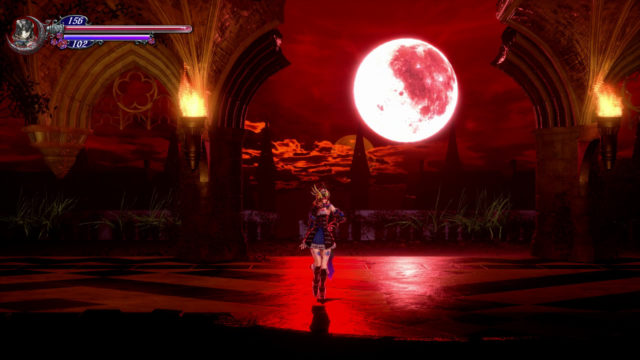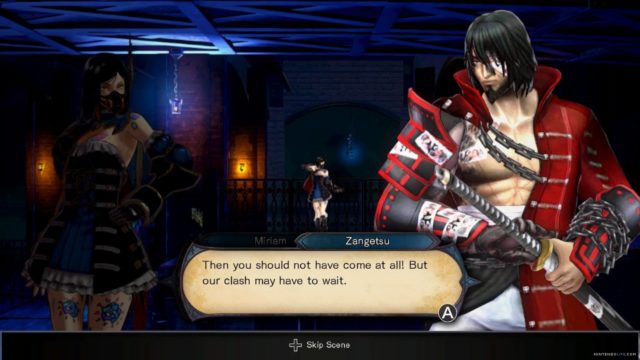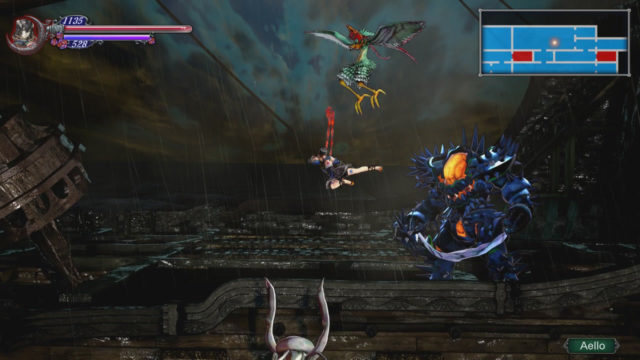A well-executed take on classic gameplay concepts; great art direction and music; rewarding character customization; strong replay value right now and promise of even more to come
Occasional technical hitches including the rare crash; early game flow hindered by difficulty curve and limited mobility; some uninteresting boss fights
Though the Castlevania series launched back in the 80s and perhaps had its most celebrated entry in 1997 with Symphony of the Night, the franchise has long held a special place in the heart of many Nintendo gamers. The GBA launched with the excellent Circle of the Moon and its success kicked off a succession of portable entries across that handheld as well as DS, and 3DS. However, that streak came to an end as Konami moved away from traditional game development and longtime series producer, Koji Igarashi, left the company. However, in 2015 the celebrated developer launched a hugely successful Kickstarter for a spiritual successor to the beloved series and now, four years later, we finally have it in the form of Bloodstained: Ritual of the Night.
Bringing back Dracula and vampire hunters would probably be a little too close to Castlevania for Konami’s legal team, so Bloodstained presents a brand-new scenario and cast of characters. You control the Shardbinder Miriam, a woman infused with the power of demonic crystals by Alchemists who wanted to use their power to remind a rapidly industrializing world of the might of magic. The hordes of demons unleashed in this event were eventually fought back, but it left all but two Shardbinders dead: Miriam and her friend Gebel. Years later, though, Gebel has allied himself with a demonic force and summoned forth a monster-filled castle from the plains of hell to once again wreak havoc upon humanity and Miriam and her allies must set forth to stop him.
Overall, the story is fairly decent throughout, with enough interesting plot and character hooks to keep you interested. None of the twists are exceptionally shocking nor the dialogue especially gripping, but there’s enough to elevate it beyond being inconsequential. The strongest aspect is really just the world itself and the backstories of the events and people involved. A few interesting ideas are brought up early on that never really get explored, though one gets the impression they could prove worthwhile plot points in future games.
While the story and characters might be new, the gameplay throughout Bloodstained will undoubtedly feel familiar to anyone who has played post-Symphony of the Night Castlevania games. While the environments and characters are modeled in 3D, the whole game is presented from a side-scrolling perspective as you explore the castle, do battle with its inhabitants, and collect new items and gear.

Key to these types of games is the sense of character progression, and once again this game doesn’t try to change up the formula. Miriam grows stronger in a number of ways. Experience earned through combat levels the heroine up, thus providing stat increases. New weapons, armor, and accessories have a similar effect. Hidden power-ups throughout the castle provide HP and MP boosts. Collected ingredients can be used to cook new meals that provide permanent stat increases upon initial consumption. Demon shards randomly dropped from defeated foes can also provide boosts in addition to new abilities, both passive and active. Altogether, the player has plenty of options for customizing Miriam, especially when it comes to how they choose to balance her for physical and magical combat.
While exploration is a vital part of the game, combat is really the main focus, and here the player has quite a bit of meaningful choice. First, the game features several different varieties of weapons, including various blades, spears, and even guns. Knives are fast but don’t hit for much damage and have little range. Boots turn Miriam into a Kung-Fu master and boost damage from her slide kick ability. Normal swords are fairly balanced while greatswords deal massive damage across their slow, arching swing. Guns are an especially unique option as their default attacks are generally rather weak, but they keep you at a distance and consumable ammo can be used for much greater damage as well as unique effects. In fact, within all the weapon types there are unique weapons that feature extra attack options, such as the ability to charge up before releasing a blow or various elemental effects. Bookcases scattered throughout the castle also teach special skills for specific weapons that require directional inputs similar to a fighting game.
The other major facet of combat comes from your choice of equipped shards. Every foe has a shard you can collect and there are even extra ones you can craft, and each presents new options for attacks, stat boosts, or other skills. While the sheer number of shards is impressive, it’s highly unlikely you will find each one useful, and instead you’ll end up sticking to a select few of your favorites, in addition to the handful of shards earned from bosses that are needed to progress through certain areas of the game. Thankfully, you are able to save a number of load-outs for both gear and shards that can quickly be selected through a radial wheel you can bring up at any time. This makes both combat and exploration all the more enjoyable, as you can easily adapt to match your current situation.

As time tested as many of these mechanics are, they don’t necessarily achieve perfection this time around. Metroid and Castlevania have inspired many games and many have made noteworthy advances for the subgenre, most notably in terms of creating faster, more fluid combat. Bloodstained feels good, and the addition of your backwards dash and later abilities helps increase the pace a bit, but overall it still feels a little slow compared to its contemporaries. Of course, this might make the game all the more appealing for those looking to relive this somewhat older approach, but for others it might feel a bit clunky. Regardless, I feel the game could have benefited from a slight boost to overall speed as well as the quicker addition of certain mobility based abilities such as the double jump.
Seeing all these ideas come together reveals a satisfactory flow and general progression, though it’s not without its flaws. Just as Miriam’s mobility takes too long to really expand, her overall sense of power also grows a little too slowly. Yes, it makes sense for the character to feel weaker early on, but the curve feels a little too steep early on, especially for one major boss fight that easily trumps everything else in the first two thirds of the game. However, once you get past this point and start amassing your arsenal of shards, weapons, and power-ups, the game hits a very enjoyable stride. The only other issue here is a relative lack of interesting bosses in the middle stretch.
While a discussion of visuals is absolutely necessary in any review, the fact we are focusing on the Switch version makes things especially interesting. At this point, you might have seen a variety of headlines that would have you believe the Switch version is an utter mess, but these stories are largely overblown. Yes, I did encounter frustrating crashes a few times, but the many complaints about how the game looks and runs aren’t all that noteworthy. Having experienced the game without seeing it on other systems, I thought it looked really good throughout. Character models are filled with tons of detail and beautifully animated, and the castle itself features plenty of great atmospheric lighting and aesthetic variety. The framerate gets a little choppy from time to time bit there are only a couple areas where it is consistent enough to be mildly annoying, and these portions are short-lived. I should note these impressions ring true for both portable and docked play.

Bloodstained doesn’t just feature Castlevania’s most celebrated producer, but it also has iconic composer Michiru Yamane lending her exceptional talents to the soundtrack. For anyone familiar with those older games’ music, Bloodstained feels like a natural continuation without skipping a beat. The overall tone is tinged with gothic stylings that feel rooted in the instrumentation and energy unique to 80s and 90s Japan. The variety of different areas and characters also lends plenty of chances for themes featuring different styles and feels. The sound effects feel appropriate, if not a little generic, though the voice acting feels more solid throughout.
Also in keeping with its genre’s traditions, Bloodstained gives you a respectable chunk of gameplay. A playthrough of the story on normal difficulty will likely run around 15 hours, but beyond that you can revisit the adventure with a new game plus feature, try the hard difficulty, or tackle the more tailored Boss Rush and Speedrun modes. Free DLC expansions have been promised that will add new characters and modes, but even as it stands right now, the game will likely give you plenty of reasons to keep playing.
Between the time Konami stopped producing new Castlevania games and Bloodstained’s release, many new games have come along from indie developers carrying a similar torch. The likes of Hollow Knight, Guacamelee, Axiom Verge and many more have not only kept the Metroidvania concept alive, but they’ve evolved it, pushing it in new and interesting directions. This is perhaps both good and bad for Bloodstained as on the one hand it feels like a somewhat more traditional effort, but it might have also benefited from looking more seriously at how those other games improved the formula. Regardless, it doesn’t change the fact that the overall package is well worth playing as it stands.
Beyond the time-tested mechanics, gamers also get an experience that looks and sounds really good. Even with the Switch’s inferior processing power, it runs more than well enough. Of course, there are still worthwhile improvements beyond the need to fix any crashes. A few slight tweaks to the early game difficulty curve and earlier access to a few mobility oriented powers would have been nice, but those are small hurdles in lengthy, and fun, enough experience that will almost certainly keep you interested beyond the initial playthrough. Altogether, it’s the worthwhile successor many fans have been waiting for.
Nintendojo was provided a copy of this game for review by a third party, though that does not affect our recommendation. For every review, Nintendojo uses a standard criteria.




 ShareThis
ShareThis





